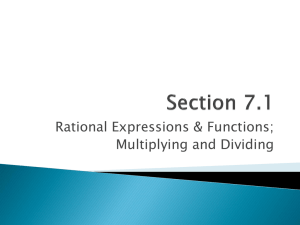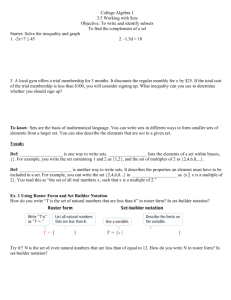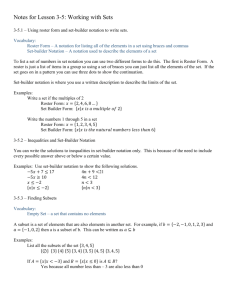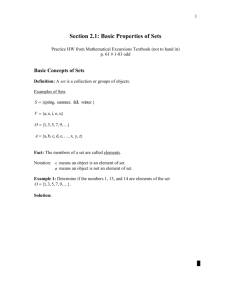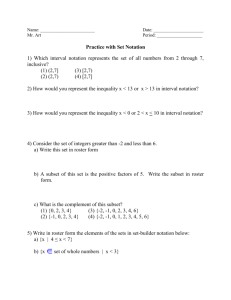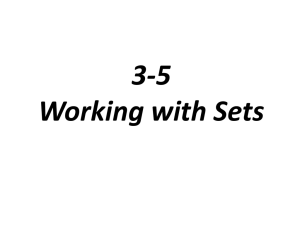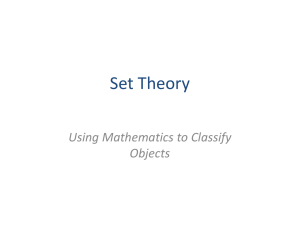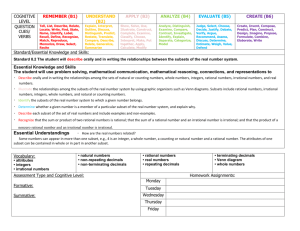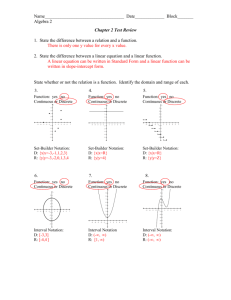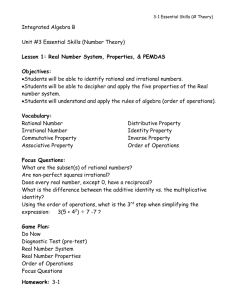Name
advertisement
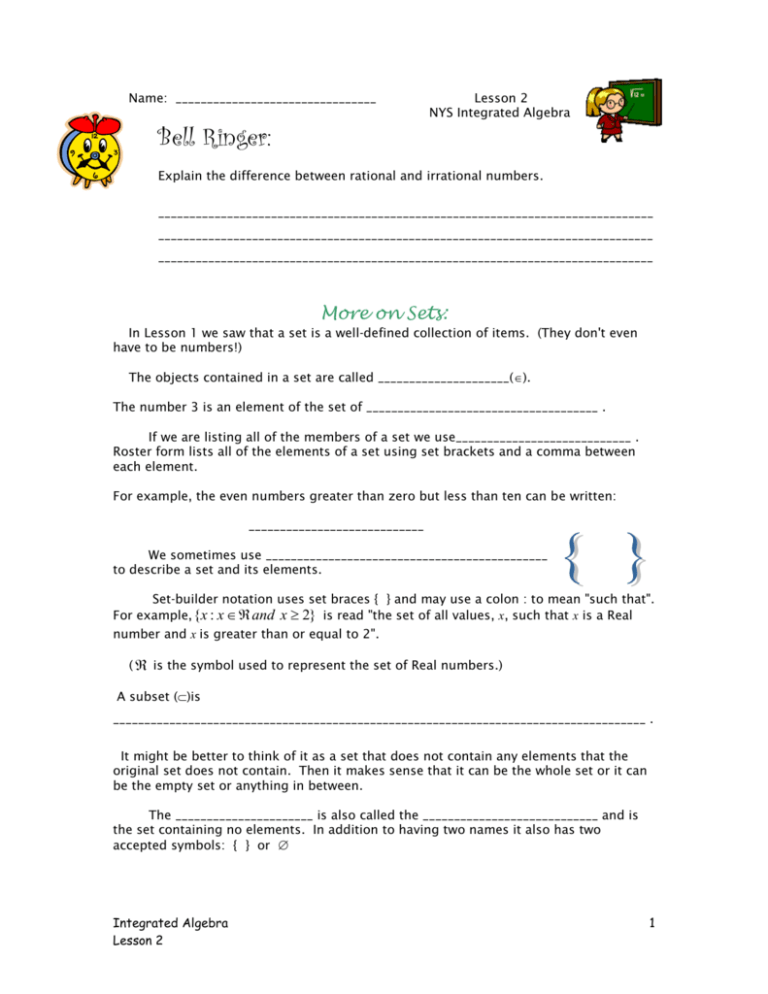
Name: ________________________________
Bell Ringer:
Lesson 2
NYS Integrated Algebra
Explain the difference between rational and irrational numbers.
_______________________________________________________________________________
_______________________________________________________________________________
_______________________________________________________________________________
More on Sets:
In Lesson 1 we saw that a set is a well-defined collection of items. (They don't even
have to be numbers!)
The objects contained in a set are called _____________________().
The number 3 is an element of the set of _____________________________________ .
If we are listing all of the members of a set we use____________________________ .
Roster form lists all of the elements of a set using set brackets and a comma between
each element.
For example, the even numbers greater than zero but less than ten can be written:
____________________________
We sometimes use _____________________________________________
to describe a set and its elements.
Set-builder notation uses set braces { } and may use a colon : to mean "such that".
For example, {x : x and x 2} is read "the set of all values, x, such that x is a Real
number and x is greater than or equal to 2".
( is the symbol used to represent the set of Real numbers.)
A subset ()is
_____________________________________________________________________________________ .
It might be better to think of it as a set that does not contain any elements that the
original set does not contain. Then it makes sense that it can be the whole set or it can
be the empty set or anything in between.
The ______________________ is also called the ____________________________ and is
the set containing no elements. In addition to having two names it also has two
accepted symbols: { } or
Integrated Algebra
Lesson 2
1
Examples:
2,3,5 and 5, 4,6 are both subsets of the set 1, 2,3, 4,5,6 .
The set of all odd numbers is a subset of the set of all real numbers.
The set of real numbers has many subsets. Two of these are the set of rational
numbers and the set of irrational numbers.
The union ( ) of two or more sets is the set of all elements contained in at least
one of the sets.
Examples:
The set of Real numbers, , us the union of the set of rational numbers and the set of
irrational numbers. This means that there is no element in that is neither a rational
number nor an irrational number.
1,3,5 1, 2, 4,6
______________________________
(There is no need to repeat an element that appears more than once.)
**Remember that the union of two or more sets must always be at least as large as
the largest set you are finding the union of!
The intersection ( ) of two or more sets is the set of all elements that are
common to all of the given sets.
Examples:
a, b, c, d , e, f c, d , e, f , g, h ________________________
2, 4, 6,8 1,3,5, 7 ___________________
Integrated Algebra
Lesson 2
2
Name: ________________________________
Lesson 2
NYS Integrated Algebra
On Your Own:
(Note that the asterisked questions are those directly from today’s lesson. Other
questions may be from any previous lesson.)
1. *Copy the definitions for the following terms in your glossary:
a. elements
b. roster form
c. set-builder notation
d. subset
e. empty set/null set
f. union
g. intersection
2. * Write "the set of all values, x, such that x is a Real number and x is less than 10"
in set-builder notation.
____________________________
3. * Write "the set of all values, x, such that x is a Real number between 15 and 20" in
set-builder notation.
4. *Write what
x : x and x 5 means in words.
____________________________
________________________________________________________________________________
________________________________________________________________________________
5. *Write the set containing the first 6 odd numbers greater than 0 in roster form.
____________________________
6. *Matching: Match each term in column A with its symbol in column B. Terms or
symbols may have multiple matches.
A
_______ a. set brackets
B
1.
_______ b. union
2.
_______ c.
3.
null set
_______ d. empty set
4.
_______ e. intersection
5.
_______ f. element
6.
_______ g. the set of real numbers
7. { }
_______ h. subset
Integrated Algebra
Lesson 2
3
7. * 2,3,5,8,9 8,9,10,11
_____________________
8. * a, b, c x, y, z
_____________________
9. * 2,3,5,8,9 8,9,10,11
_____________________
10. *
a, b, c x, y, z
_____________________
11. *
a, b, c
_____________________
12. *
1, 2,3
_____________________
13. Which of the following is a rational number?
(a)
(b) 1.23456...
(c) 9.9899799699... (d) 4.3
______________
14. Write the number 5 as the ratio of two integers.
______________
Math Musings:
15. Tell about the one topic you found most confusing in the math course you took
last year.
___________________________________________________________________________________
___________________________________________________________________________________
___________________________________________________________________________________
___________________________________________________________________________________
___________________________________________________________________________________
Integrated Algebra
Lesson 2
4
